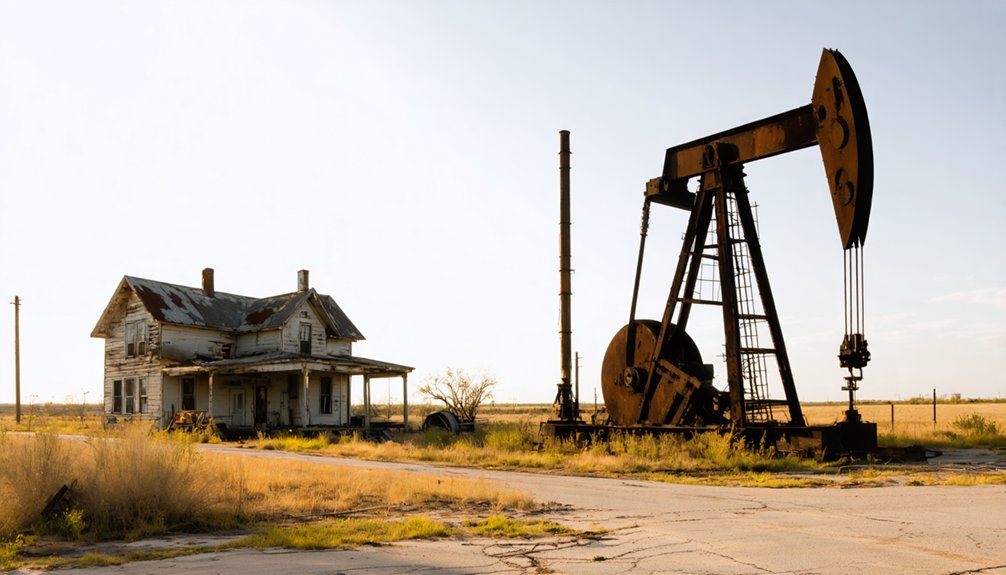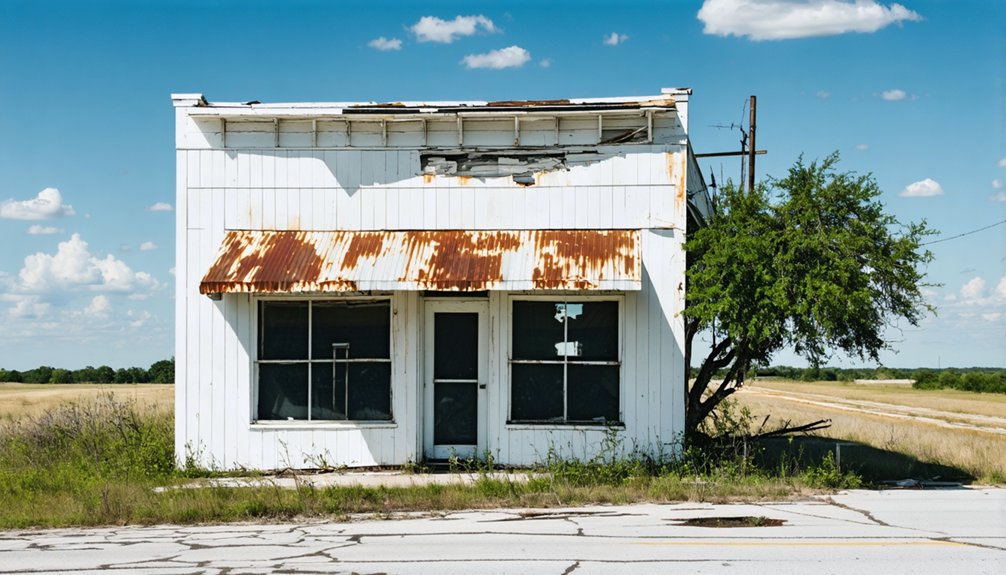You’ll find Newgulf, Texas along the Gulf Coast, established in 1928 as a company town by Texas Gulf Sulphur Company. During its prime, this mining community housed over 1,500 residents and produced more than 80 million tons of sulfur using the Frasch method. The town featured 400 company houses, churches, stores, and a golf course. Today, you can explore the scattered ruins and foundations of this once-thriving industrial powerhouse, where nature slowly reclaims its historic streets.
Key Takeaways
- Newgulf was established in 1928 by Texas Gulf Sulphur Company and became a thriving industrial town centered around sulfur mining operations.
- The town reached its peak population of 1,586 residents during the 1920s-1940s with 400 company houses and extensive community facilities.
- Economic decline began in the late 1950s due to falling sulfur prices and industry changes, leading to widespread layoffs and population loss.
- The site operated until 1993, producing over 80.8 million long tons of sulfur before operations ceased completely.
- Today, only scattered ruins, weathered foundations, and overgrown streets remain, with no maintained access or preservation efforts at the site.
The Birth of a Company Town
When the Texas Gulf Sulphur Company discovered rich sulfur deposits beneath the Boling Dome in 1928, they quickly established Newgulf as a purpose-built company town to support their mining operations.
You’ll find that this wasn’t their first venture – they’d already built a similar town near Big Hill Dome, but the discovery of new sulfur reserves prompted them to create Newgulf as a replacement.
The company’s mining legacy began in March 1929 when they started using the innovative Frasch method, which extracted sulfur by melting it underground with steam.
The massive Boling Dome site, spanning 5,500 acres, would soon become one of the world’s largest sulfur producers, eventually yielding 80.5 million long tons of sulfur by 1990.
This strategic location marked the beginning of a new chapter in Texas’s industrial history, leading to the construction of over 350 company homes and essential community facilities.
Life in New Gulf’s Prime Years
The vibrant community of Newgulf came alive during its prime years between the late 1920s and 1940s, reaching its peak population of 1,586 residents.
Nestled in its heyday, Newgulf flourished as a bustling town of 1,586 souls during the interwar years.
You’d find yourself in a close-knit town where life revolved around the sulfur plant, with uniformly built houses and convenient access to essential services along a four-lane avenue. The community’s name was chosen through a contest won by Marie Ertz. Much like the town of Terlingua’s mining operations, the sulfur industry was the backbone of the local economy.
Your daily life would’ve included shopping at one of two grocery stores, catching a film at the movie theater, or enjoying community events at the company clubhouse.
Social activities flourished through four different churches, Scout programs, and gatherings at the nine-hole golf course.
You wouldn’t have to leave town for much – with fifteen businesses, including pharmacies, a cafe, and dry-goods stores, plus a hospital and schools, Newgulf provided everything a working family needed.
Industrial Operations and Economic Impact
You’ll find that New Gulf’s industrial might centered on the Boling Dome, which produced over 80.8 million long tons of sulphur through the Frasch extraction method between 1929-1993.
Initial employment began with only 25 workers when mining operations first launched in 1919, before growing substantially in later years.
The Texas Gulf Sulphur Company built extensive infrastructure to support these operations, including power plants, machine shops, rail systems, and a deepwater canal connecting to the Gulf of Mexico. A significant development came in 1984 when the company completed a seventy-megawatt cogenerating plant.
During World War II, the facility’s strategic importance peaked as workers exceeded production targets by 50% above prewar levels, earning five Army-Navy “E” Awards for excellence.
Mining Infrastructure Details
Mining operations at Newgulf revolutionized sulfur extraction through implementation of the Frasch method, a groundbreaking process that injected high-pressure steam underground to melt and extract liquid sulfur. This mining technology transformed the Boling Dome into one of the world’s most productive sulfur mines, yielding over 80 million tons by 1990.
The development of the gas purification plant in 1941 marked a significant advancement in sulfur processing capabilities. You’ll find the infrastructure development was extensive, with Texas Gulf Sulphur investing heavily in specialized equipment and facilities to support the Frasch process. The company established sophisticated steam injection systems and extraction machinery that considerably reduced the need for manual labor.
They also pioneered methods to process sour gas for sulfur extraction, demonstrating their commitment to maximizing resource utilization. The mining complex’s advanced capabilities positioned Texasgulf as a dominant force in the global sulfur industry.
Economic Rise and Fall
Since its establishment in 1928, Newgulf rapidly emerged as an industrial powerhouse after Texas Gulf Sulphur Company tapped into the Boling Dome’s vast sulfur deposits. The economic transformation mirrored the state’s shift from agricultural roots to industrial development.
You’ll find the town’s economic resilience reflected in its peak population of 1,586 by 1940, supported by innovative sulfur extraction processes and a thriving company town model. The discovery of sulfur deposits by two St. Louis investors in 1909 laid the foundation for the town’s future development.
The town’s remarkable industrial achievements included:
- Production of over 50 million tons of sulfur by 1958
- Construction of 400 company houses for workers
- Development of essential community facilities like hospitals and schools
- Support for up to fifteen local businesses
- Creation of a strong community identity through shared amenities
However, you’d have witnessed the town’s decline by the late 1950s as sulfur prices dropped, market competition increased, and operations gradually wound down, ultimately leading to its ghost town status.
Community Facilities and Daily Life
Built to serve Texas Gulf Sulphur Company employees, New Gulf boasted an impressive array of community facilities that made daily life surprisingly comfortable for a company town of its era.
You’d find all your daily needs met along the four-lane main avenue, from groceries and pharmacies to a tailor and barbershop. Community amenities included a hospital where many residents were born, four churches serving different denominations, and a library with post office. Much like Independence Baptist Church in Independence, Texas, these churches served as important community gathering places.
The town’s social events centered around the clubhouse, which featured a nine-hole golf course.
You could catch a movie at the theater, join Scout activities at their dedicated clubhouse, or attend gatherings at the guest lodge.
While the era’s segregation shaped the town’s layout, the facilities created a self-contained community where residents rarely needed to venture elsewhere.
The Decline of a Mining Empire

You’d find Newgulf’s decline particularly stark as the Texas Gulf Sulphur Company faced devastating market changes in the late 1950s, including overproduction issues and plummeting foreign sulfur prices.
The company’s subsequent layoffs and operational shifts to other locations triggered a rapid exodus from the town, with many employees relocating for work elsewhere.
Mining Operations Cease Operations
After dominating global sulfur production for over six decades, Boling Dome‘s mining empire came to an end in 1993.
Advanced mining techniques and automation had already reduced the workforce considerably by the 1980s, signaling the operation’s inevitable decline.
You can trace the final chapter of this industrial giant through these key developments:
- Elf Aquitaine’s acquisition of Texas Gulf Sulphur Company in 1981 marked a shift in corporate priorities.
- Rising operational costs and falling sulfur prices made the mine less competitive.
- Competition from petroleum refining byproducts undercut traditional Frasch process mining.
- Easily accessible ore became depleted after extracting over 80.5 million tons.
- The company began dismantling facilities and infrastructure in January 1995.
These factors converged to transform what was once the world’s largest sulfur-producing mine into an abandoned industrial site.
Community Exodus Begins Fast
When foreign sulfur prices plummeted in 1956, Newgulf’s economic foundation began to crumble. You’d have witnessed a devastating chain reaction as Texas Gulf Sulphur Company’s market flooded, triggering widespread layoffs amid the 1957 recession.
The company’s decision to build plants elsewhere only hastened the community migration.
What followed was a rapid social fragmentation of this once-thriving town. You’d have seen your neighbors’ houses standing empty by 1961 as families sought opportunities elsewhere.
The town’s population, which had peaked at 1,586 in 1940, steadily declined as technological advances reduced the need for workers. Businesses shuttered, community events ceased, and the social fabric unraveled.
What Remains Today
Today’s visitors to New Gulf will find little more than scattered ruins and foundational remains along the Texas Gulf Coast. Your ghost town history exploration will reveal a landscape that’s been reclaimed by nature, where remnants of the past slowly fade into the coastal terrain.
When you venture to explore what’s left, you’ll discover:
- Weathered building foundations and occasional roofless structures scattered across the site
- Historic roadways and former street patterns, now barely visible beneath overgrown vegetation
- A modest cemetery with weathered stones dating back to the early 20th century
- Ruins affected by coastal erosion, with some portions potentially submerged
- Unmanaged land that’s reverted to pasture, with no maintained access roads
The site lacks official markers or preservation efforts, making your visit a true journey into unrestored history.
Frequently Asked Questions
What Happened to the Original Town Records and Company Documents?
You’ll find most records weren’t preserved, with missing archives likely discarded during company changes. Texas Gulf Sulphur Company retained documents internally, but their fate remains unclear after operations ceased.
Are There Any Surviving Photographs of the Town’s Early Years?
Like fragments of time frozen in silver, you’ll find historic images in SMU’s digital archives, with 49 photographs from 1939 showing the town’s facilities, daily life, and company operations.
Can Visitors Legally Explore the Remaining Structures and Ruins Today?
No, you can’t legally explore the structures since they’re on private property. There aren’t any official ghost tours, and legal restrictions strictly prohibit unauthorized access due to safety and liability concerns.
Were There Any Major Accidents or Disasters at the Sulfur Mine?
Like a dark chapter in history, you’ll find one major historical disaster at New Gulf’s sulfur mine – the devastating 1963 Cane Creek explosion that killed 18 miners and reshaped mining practices.
What Environmental Impact Did the Sulfur Mining Leave on the Area?
You’ll find lasting damage from sulfur pollution in the air and groundwater, plus severe habitat destruction from land subsidence that created dangerous sinkholes and altered natural water flow patterns.
References
- https://www.youtube.com/watch?v=JLLNVSg65DU
- https://mix941kmxj.com/see-how-two-texas-ghost-towns-battled-for-the-county-and-lost/
- https://kfyo.com/texas-ghost-town-the-mysterious-and-gruesome-story-of-baby-head/
- https://en.wikipedia.org/wiki/Indianola
- https://blog.smu.edu/smulibraries/2014/03/18/newgulf-from-sulfur-boomtown-to-texas-ghost-town/
- https://knue.com/texas-gulf-ghost-town-indianola/
- https://forum.tracesoftexas.com/topic/226-story-about-newgulf-texas/
- https://www.youtube.com/watch?v=u3tfE_tr-0w
- https://www.texasescapes.com/TexasGulfCoastTowns/Newgulf-Texas.htm
- https://texashistoricalmarkers.weebly.com/texas-gulf-sulphur-company-newgulf.html



